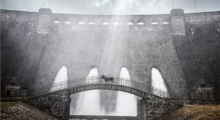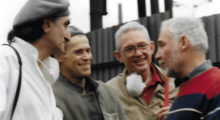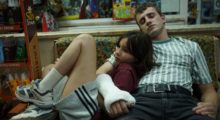18145 Results for “”
-
Crafting a Life as a Filmmaker: Ashley McKenzie on Queens of the Qing Dynasty

Queens of the Qing Dynasty, the second feature from Nova Scotia’s Ashley McKenzie, is a unique work of independently produced Canadian cinema. Both a stark about-face from the hardscrabble realism of her 2016 debut Werewolf—about a pair of strung-out young lovers living hand-to-mouth on the margins of Cape Breton—and a decisive break from the docufiction trends of art cinema at large, Queens is rigorously composed and austerely dramatized, an artful fable pitched somewhere between comedy and tragedy. Starring newcomer Sarah Walker as Star, a neurodivergent teen who develops a deep connection with her caregiver An (Ziyin Zheng, also making their […]
by Jordan Cronk on Sep 30, 2022 -
Trailer Debut: Cinque Northern’s Angola Do You Hear Us? Voices From A Plantation Prison

Filmmaker is pleased to share the trailer debut of Cinque Northern’s short film Angola Do You Hear Us? Voices From A Plantation Prison, distributed by MTV Documentary Films. The documentary follows playwright Liza Jessie Peterson’s journey to bring her one-woman show The Peculiar Patriot to the Louisiana State Penitentiary at Angola. Peterson’s interest in this prison, specifically, comes from its history as a pre-Civil War plantation (originally named “Angola” after the African country that many of its enslaved inhabitants were violently taken from) before it was bought by the Louisiana Department of Public Safety & Corrections in 1901. It is […]
by Filmmaker Staff on Sep 30, 2022 -
14 Films (and Other Recommendations) at the 60th New York Film Festival

With the opening night of the 60th New York Film Festival upon us, Filmmaker would like to recommend 14 titles to catch during the 17-day engagement, which runs from September 30 through October 16 in-person at Film at Lincoln Center. Over the course of our previous festival coverage from this year—including Sundance, Cannes, Venice and TIFF—many of these films have been featured on our site in critical dispatches and reviews. Below, we share links and excerpts from these director interviews and festival dispatches, highlighting Jerzy Skolimowski’s Eo, Véréna Paravel and Lucien Castaing-Taylor’s De Humani Corporis Fabrica, Kelly Reichardt’s Showing Up […]
by Scott Macaulay on Sep 30, 2022 -
NYFF 2022: White Noise

Can product placement ever transcend advertising? Pepsi’s vintage logo—a comically over-present staple of ’80s and ’90s commercial Hollywood filmmaking—is continuously conspicuous in Noah Baumbach’s adaptation of Don DeLillo’s White Noise. As a period marker, this makes sense: the novel was published in 1985 and the film’s production design places it in the early ’80s. Thematically, it’s obviously relevant: DeLillo’s first-person narrator, J.A.K. Gladney (Adam Driver), regularly has his thoughts interrupted by lines that simply list corporate names or interpolate overheard advertising chatter. DeLillo originally thought of naming the book Panasonic, writing to his editor that “The word ‘panasonic,’ split into its component […]
by Vadim Rizov on Sep 30, 2022 -
Chayse Irvin on Shooting Blonde in Digital Black and White and God’s Creatures in 35mm Color

This week, Netflix’s Blonde and A24’s God’s Creatures head to streaming and theaters, respectively. The digitally-shot Blonde is a highly stylized look at the life of Marilyn Monroe, shifting aspect ratios and alternating between color and monochrome while employing extreme wide angle lenses, body cam mounts, infrared and more to expressionistically convey Monroe’s perspective. God’s Creatures is the antithesis—austere and somber, captured on 35mm, with an observational point of view distanced from the main characters, a mother in a small Irish fishing village whose life crumbles after providing a false alibi for her son. The films do share one thing in common—cinematographer […]
by Matt Mulcahey on Sep 29, 2022 -
“We Often Speak of the Film as a ‘Making-of-a-Ghost’ Story”: Saela Davis and Anna Rose Holmer on God’s Creatures

The brackish waves of the Atlantic are a source of livelihood and peril for the inhabitants of a coastal Irish fishing village in God’s Creatures, the directorial work of Saela Davis and Anna Rose Holmer. Aileen O’Hara (Emily Watson) is the manager of a local fishing plant, tasked with sifting through daily catches of oysters and haddock on a whirring conveyor belt and preparing them for market. She is diligent yet warm, providing a maternal presence for many of her employees, namely young Sarah (Aisling Franciosi, The Nightingale). During an ordinary shift, Aileen and a handful of other employees witness […]
by Natalia Keogan on Sep 29, 2022 -
Metrograph Tribute to the Brothers Young Recalls Heroic Era in Indie Filmmaking

Since the passing in January of Irwin Young, chief mensch at New York’s fabled DuArt Film Lab, there has been an outpouring of tributes and reminiscences, including a packed memorial at Lincoln Center in May. But no tribute has been more on point than “The Process: A Tribute to Robert and Irwin Young,” the Metrograph’s recent 24-film series dedicated to Irwin, the lab’s owner, and older brother, director Robert M. “Bob” Young, for the epic contributions they jointly made to the American indie film scene from the 1960s through the 1990s. For the big screen is precisely where the Young […]
by David Leitner on Sep 28, 2022 -
Cobra Kai Star Xolo Maridueña on His Year of Acting Revelations (Back to One, Episode 222)

Xolo Maridueña has been playing Miguel Diaz on the hit series Cobra Kai for five seasons, starting when he was 16 years old. On this episode, he talks about how preparing for his dream role as Blue Beetle (in the eponymous D.C. superhero movie coming out next year) sent him down a road that expanded his acting capabilities in new and exciting ways. Plus he talks about William Zabka’s positive influence on him, and the ways that played into how he took on his leadership duties when he got to be number one on the call sheet. Back To One […]
by Peter Rinaldi on Sep 27, 2022 -
Trailer Watch: Charlotte Wells’s Aftersun

The trailer has arrived for Aftersun, the feature debut from Scottish writer/director (and former 25 New Faces of Film) Charlotte Wells. The film chronicles the relationship between a doting father and his pre-teen daughter, specifically through the lens of a formative vacation they took to a resort in Turkey. After premiering at this year’s Cannes Critics’ Week to much acclaim, Aftersun was selected for further festival programming at Telluride, TIFF and will now screen at the 60th New York Film Festival. The film’s official synopsis reads: At a fading vacation resort, 11-year-old Sophie treasures rare time together with her loving […]
by Filmmaker Staff on Sep 27, 2022 -
Trailer Watch: Nina Menkes’s Brainwashed: Sex-Camera-Power

Independent filmmaker Nina Menkes (Queen of Diamonds, The Bloody Child, Phantom Love) returns with Brainwashed: Sex-Camera-Power, a documentary that uses clips from hundreds of films to demonstrate the pervasiveness of the male gaze in the dominant cinematic canon—and the real-world misogyny that Menkes believes these depictions abet. Originally conceived as a presentation that the filmmaker gave at film festivals or as stand-alone talks, the documentary takes images from films like Vertigo, Once Upon a Time…in Hollywood and Titane in order to make its argument. The film also features an array of prominent women and non-binary industry figures speaking to the […]
by Filmmaker Staff on Sep 26, 2022










